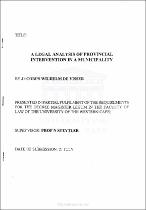| dc.contributor.advisor | Steytler, N | |
| dc.contributor.author | De Visser, Jacobus Wilhelm | |
| dc.date.accessioned | 2023-05-16T10:56:31Z | |
| dc.date.available | 2023-05-16T10:56:31Z | |
| dc.date.issued | 1999 | |
| dc.identifier.uri | http://hdl.handle.net/11394/10006 | |
| dc.description | Magister Legum - LLM | en_US |
| dc.description.abstract | With the introduction of the 1996 Constitutor local government was for the first time in South African history acknowledged as a fully-fledged 'sphere' of government and its role and responsibilities as an equal partner of national and provincial government gained momentum. Local government no longer was an instrument at the hands of national government, used to implement its apartheid policies and practices. Instead, it became one of the three "distinctive, interdependent and interrelated spheres of government and a new unexplored legal space for local government opened up. But on 18 March 1998, a crack in the newly created sphere of local government appeared. The Eastern Cape Provincial Executive intervened in the Butterworth Transitional Local Council and assumed full responsibility for the administration of Butterworth. The province used as a legal basis section 139 of the very same Constitution that provided Butterworth with this new status as being part of an 'independent and autonomous sphere of government'. | en_US |
| dc.language.iso | en | en_US |
| dc.publisher | University of the Western Cape | en_US |
| dc.subject | Constitution | en_US |
| dc.subject | Eastern Cape | en_US |
| dc.subject | Legislation | en_US |
| dc.subject | Local government | en_US |
| dc.subject | Municipal Council | en_US |
| dc.title | A legal analysis of provincial intervention in a municipality | en_US |
| dc.type | Thesis | en_US |
| dc.rights.holder | University of the Western Cape | en_US |

